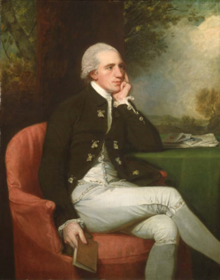William Petrie
William Petrie | |
|---|---|
 portrait by George Romney | |
| Born | 1784 |
| Died | 27 October 1816 |
William Petrie (1747 – 27 October 1816)
Life
East India Company career
The chronology of his advancement through the Honorable East India Company is as follows:[3]
- 1765 - Writer
- 1771 - Factor
- 1774 - Junior Merchant
- 1776 - Senior Merchant; At Home
- 1778 - In India
- 1782 - At Home
- 1790 - Member of the Council of the Governor
- 1793 - At Home
- 1800 - President of the Board of Revenue, and Member of the Council of the Governor
- 1809 - Appointed Governor of the Prince of Wales Island
- Died 27 October 1816, at Prince of Wales Island.
Astronomy
In 1786, Petrie set up a private observatory as a geographical and navigational aid in his residence in
Petrie was a Member of Council in Madras in the 1790s, and acted for three months as Governor of Madras in 1807.[5]
He was elected a Fellow of the Royal Society in November 1795.[6]
Governor of Penang
Petrie received his appointment on 29 Nov 1811 probably owing to
Petrie served as Acting Governor till the end of Seton's official rule and then as Governor of Penang from September 1812 to October 1816. He died, aged 69,[7] while still in office, and is buried at the Old Protestant Cemetery, George Town.
A number of the “interactions” with the public by the Governors were recorded in the Prince of Wales Island Gazette. In the last days of 1813, Petrie requested that “the Gentlemen of His Majesty’s and the Honorable Company’s Civil, Naval and Military Service, and the other Gentlemen of the Settlement will honor him with their company at Breakfast at half past eight; and at dinner, at half past four o’clock, on New Year’s Day.”[8]
Following his death, his 'widow' was granted a pension by the East India Company. She was not legally his widow, but a Eurasian woman, Mrs Warren, the daughter of Jean Baptiste François Joseph de Warren, an officer in the French army at Pondicherry. She bore Petrie five children, and later died at her home in Baker Street, London on 20 March 1819.[1]
References
- ^ ISBN 9789814634786.
- ^ a b c Kochhar, Rajesh (4 April 2011). "William Petrie (d.1816), Madras Civil Servant 1765-1812 and Governor,Penang 1812-1816". Rajesh Kochhar. Retrieved 4 April 2019.
- ^ Prinsep, Charles Campbell (1885) Record of services of the Honourable East India Company's civil servants in the Madras presidency, from 1741 to 1858. London. Trübner. Page 113
- ^ ISBN 9788131728185., pp.669-719.
- ^ Buckland, C. E., Dictionary of Indian biography, 1906
- ^ "Library and Archive Catalog". The Royal Society. Retrieved 4 October 2010.
- ^ "William Petrie, fifth Governor of Penang". Old Protestant Cemetery, Penang. 6 February 2016. Retrieved 4 April 2019.
- ^ New Ways of Knowing: The Prince of Wales Island Gazette—Penang’s First Newspaper by Geoff Wade, University of Hong Kong; Email [email protected], Presented at The Penang Story – International Conference 2002 18–21 April 2002, The City Bayview Hotel, Penang, Malaysia organised by The Penang Heritage Trust & STAR Publications
